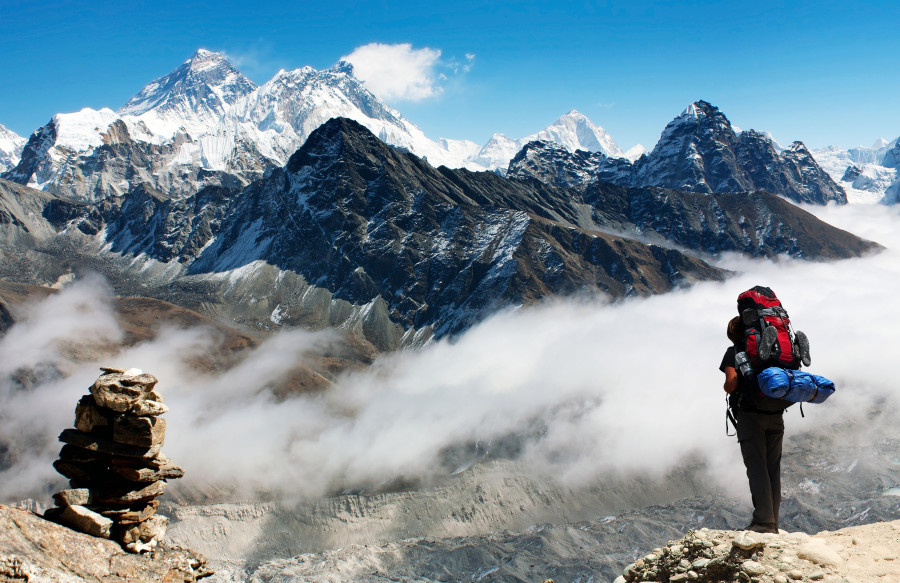Money
Planned autumn attempts on Everest cancelled due to bad weather
Climbers said that the 'post-monsoon' autumn season on the world's highest peak was a tough one this year.
Sangam Prasain
Two planned attempts on Everest in the autumn season, the first after 10 years, were abandoned as poor weather conditions continued throughout September, the agencies handling the expeditions said.
Spring is the ideal season for mountaineers. Climbing Everest in the autumn is especially challenging due to extreme post-monsoon weather events and fresh snow, and only experienced climbers attempt the feat.
The Department of Tourism had issued permits to 10 climbers—four American, four Polish, one British and one Spanish—to make a bid to scale Everest this autumn. They had to drop their plans as the post-monsoon extended for nearly two weeks, causing disturbances in the weather pattern.
According to the Department of Hydrology and Meteorology, the monsoon which generally lasts up to September 23 remained active for 10 more days this year.
Mingma Sherpa, chairman of Seven Summit Treks, said all the climbers had already gone back to their homes. “Due to the bad weather condition after mid-September, it was difficult to fix ropes and ladders on the world’s highest peak,” said Sherpa who handled the group of Polish climbers.
According to him, most of the climbers had abandoned their autumn mission by the first week of October.
Madison Mountaineering, which had handled a nine-member team of high-profile climbers, wrote on its website that the ‘post-monsoon’ autumn season on 8,000-metre peaks was a tough one this year.
“The monsoon came late and was very heavy, significant amounts of snowfall continued to accumulate daily throughout the time we were on Everest, rather than the typically drier weather of September,” renowned mountaineer Garrett Madison from Madison Mountaineering wrote on his website.
“We’ve wrapped up our Everest expedition for the 2019 autumn season, and everyone is heading home. There were no summits of Everest this season by our team or any of the teams attempting the peak.”
Madison said that this year there were some of the world’s best high-altitude climbers and skiers. “However, the conditions were such that we’ve all accepted the mountain was not in a safe enough condition to make a reasonable attempt.”
Madison wrote that after establishing the route to Camp 1, they discovered a large column of ice that was precariously hanging above the icefall route. “After studying the serac by drone footage, we determined that when this serac fell, it would obliterate a large portion of the route, a wide area of the route was in danger with no way to avoid this section.”
None of the teams present, except for Kilian Jornet, were willing to take the risk of climbing through this section, he said. “We continued to wait patiently in base camp for the serac to fall, thereby making the route safe and reasonable for us. However, that day never came.”
Spanish ultra marathoner Kilian Jornet, who reached the Everest summit twice within a week, first on May 22 and again on May 27 in 2017 from the Chinese side without the use of supplemental oxygen and fixed ropes, decided to make the attempt, said Murari Sharma, managing director at Everest Pariwar Treks which handled the Jornet expedition.
Jornet, who had obtained a solo expedition permit, described a big 60-metre serac hanging 1,000 metres above the icefall that looked like it could collapse at any moment
Jornet wrote on his blog that he had certain climbing projects in mind this autumn, depending on the conditions and the weather. “In the end, it wasn’t possible to finish any of the projects for different reasons; but I truly enjoyed the mountains in spite of the bad weather,” he said.
“All expeditions decided to abandon the climb in late September/early October. As the weather was finally looking good in the first week of October, in September, we only had 3-4 days of sunshine, I decided to give a try," Jornet said.
“When I reached the slopes between the South Col and the Balcony, I saw that the conditions weren’t any better. There was a very unstable layer, so before reaching the Balcony, at around 8,300 metres, I turned around and went back down,” he said. “The deep and unstable snow was too risky for an avalanche.”
Jornet wrote that he was able to do a light attempt up to around 8,300 metres using a variation of the route to the summit of Everest that Polish mountain climbers took in the 1980s before he had to turn back due to avalanche conditions.
The world’s highest peak normally sees the highest number of climbers during the spring season. Very few have climbed it during the autumn. According to the Department of Tourism, the last time Everest was climbed in the autumn season was in 2010 when American Eric Larsen achieved the feat.
Before Larsen, in 2000, a South Korean and two Slovenian groups had climbed Everest in October.
The autumn season, when the monsoon ends, is regarded as more dangerous because there is typically a lot of new snow which can be unstable.
The first ascent of Everest during the autumn was recorded in 1973 when two Japanese climbers Yasuo Kato and Michio Yuasa achieved the feat on October 26, 1973.
During the 1980s, climbing in the autumn was more popular than in the spring. After the advent of democracy in 1990 in Nepal, the government adopted a liberal economic policy in 1992. As a result, Everest was also opened to everyone and during any season.




 10.12°C Kathmandu
10.12°C Kathmandu














